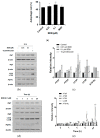5-Bromo-3,4-dihydroxybenzaldehyde Promotes Hair Growth through Activation of Wnt/β-Catenin and Autophagy Pathways and Inhibition of TGF-β Pathways in Dermal Papilla Cells
- PMID: 35408575
- PMCID: PMC9000556
- DOI: 10.3390/molecules27072176
5-Bromo-3,4-dihydroxybenzaldehyde Promotes Hair Growth through Activation of Wnt/β-Catenin and Autophagy Pathways and Inhibition of TGF-β Pathways in Dermal Papilla Cells
Abstract
Various studies addressing the increasing problem of hair loss, using natural products with few side effects, have been conducted. 5-bromo-3,4-dihydroxybenzaldehyde (BDB) exhibited anti-inflammatory effects in mouse models of atopic dermatitis and inhibited UVB-induced oxidative stress in keratinocytes. Here, we investigated its stimulating effect and the underlying mechanism of action on hair growth using rat vibrissa follicles and dermal papilla cells (DPCs), required for the regulation of hair cycle and length. BDB increased the length of hair fibers in rat vibrissa follicles and the proliferation of DPCs, along with causing changes in the levels of cell cycle-related proteins. We investigated whether BDB could trigger anagen-activating signaling pathways, such as the Wnt/β-catenin pathway and autophagy in DPCs. BDB induces activation of the Wnt/β-catenin pathway through the phosphorylation of GSG3β and β-catenin. BDB increased the levels of autophagic vacuoles and autophagy regulatory proteins Atg7, Atg5, Atg16L, and LC3B. We also investigated whether BDB inhibits the TGF-β pathway, which promotes transition to the catagen phase. BDB inhibited the phosphorylation of Smad2 induced by TGF-β1. Thus, BDB can promote hair growth by modulating anagen signaling by activating Wnt/β-catenin and autophagy pathways and inhibiting the TGF-β pathway in DPCs.
Keywords: 5-bromo-3,4-dihydroxybenzaldehyde; TGF-β; Wnt/β-catenin; autophagy; dermal papilla cells; hair growth; proliferation.
Conflict of interest statement
The authors declare no conflict of interest.
Figures







Similar articles
-
Myristoleic Acid Promotes Anagen Signaling by Autophagy through Activating Wnt/β-Catenin and ERK Pathways in Dermal Papilla Cells.Biomol Ther (Seoul). 2021 Mar 1;29(2):211-219. doi: 10.4062/biomolther.2020.169. Biomol Ther (Seoul). 2021. PMID: 33518533 Free PMC article.
-
Effects of dihydrotestosterone on rat dermal papilla cells in vitro.Eur J Pharmacol. 2015 Jun 15;757:74-83. doi: 10.1016/j.ejphar.2015.03.055. Epub 2015 Mar 30. Eur J Pharmacol. 2015. PMID: 25838072
-
Wnt10b promotes hair follicles growth and dermal papilla cells proliferation via Wnt/β-Catenin signaling pathway in Rex rabbits.Biosci Rep. 2020 Feb 28;40(2):BSR20191248. doi: 10.1042/BSR20191248. Biosci Rep. 2020. PMID: 31961392 Free PMC article.
-
Lagerstroemia indica extract regulates human hair dermal papilla cell growth and degeneration via modulation of β-catenin, Stat6, and TGF-β signaling pathway.J Cosmet Dermatol. 2022 Jul;21(7):2763-2773. doi: 10.1111/jocd.15081. Epub 2022 Jun 9. J Cosmet Dermatol. 2022. PMID: 35596731 Review.
-
Androgen modulation of Wnt/β-catenin signaling in androgenetic alopecia.Arch Dermatol Res. 2018 Jul;310(5):391-399. doi: 10.1007/s00403-018-1826-8. Epub 2018 Mar 16. Arch Dermatol Res. 2018. PMID: 29549490 Review.
Cited by
-
Association study reveals a susceptibility locus with male pattern baldness in the Han Chinese population.Front Genet. 2024 Sep 16;15:1438375. doi: 10.3389/fgene.2024.1438375. eCollection 2024. Front Genet. 2024. PMID: 39350767 Free PMC article.
-
Stimulation of hair growth by Tianma Gouteng decoction: Identifying mechanisms based on chemical analysis, systems biology approach, and experimental evaluation.Front Pharmacol. 2022 Dec 16;13:1073392. doi: 10.3389/fphar.2022.1073392. eCollection 2022. Front Pharmacol. 2022. PMID: 36588691 Free PMC article.
-
Effect and underlying mechanism of a photochemotherapy dual-function nanodrug delivery system for head and neck squamous cell carcinoma.J Transl Med. 2024 Nov 19;22(1):1043. doi: 10.1186/s12967-024-05855-8. J Transl Med. 2024. PMID: 39563418 Free PMC article.
-
Screening of Anti-Hair Loss Plant Raw Materials Based on Reverse Network Pharmacology and Experimental Validation.Curr Issues Mol Biol. 2025 Jan 20;47(1):68. doi: 10.3390/cimb47010068. Curr Issues Mol Biol. 2025. PMID: 39852183 Free PMC article.
-
The Molecular Mechanism of Natural Products Activating Wnt/β-Catenin Signaling Pathway for Improving Hair Loss.Life (Basel). 2022 Nov 11;12(11):1856. doi: 10.3390/life12111856. Life (Basel). 2022. PMID: 36430990 Free PMC article. Review.
References
MeSH terms
Substances
Grants and funding
LinkOut - more resources
Full Text Sources

